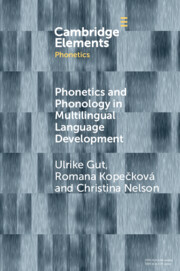Element contents
Phonetics and Phonology in Multilingual Language Development
Published online by Cambridge University Press: 26 July 2023
Summary
Keywords
- Type
- Element
- Information
- Series: Elements in PhoneticsOnline ISBN: 9781108992527Publisher: Cambridge University PressPrint publication: 31 August 2023
References
- 5
- Cited by

